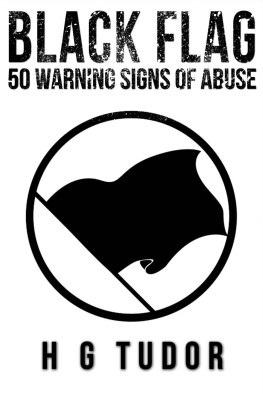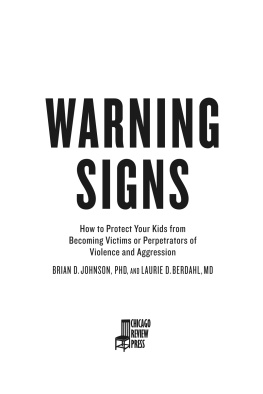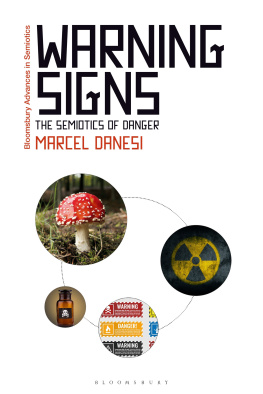H.G.Tudor - Black Flag: 50 Warning Signs of Abuse
Here you can read online H.G.Tudor - Black Flag: 50 Warning Signs of Abuse full text of the book (entire story) in english for free. Download pdf and epub, get meaning, cover and reviews about this ebook. year: 2016, publisher: Insight Books, genre: Home and family. Description of the work, (preface) as well as reviews are available. Best literature library LitArk.com created for fans of good reading and offers a wide selection of genres:
Romance novel
Science fiction
Adventure
Detective
Science
History
Home and family
Prose
Art
Politics
Computer
Non-fiction
Religion
Business
Children
Humor
Choose a favorite category and find really read worthwhile books. Enjoy immersion in the world of imagination, feel the emotions of the characters or learn something new for yourself, make an fascinating discovery.
- Book:Black Flag: 50 Warning Signs of Abuse
- Author:
- Publisher:Insight Books
- Genre:
- Year:2016
- Rating:4 / 5
- Favourites:Add to favourites
- Your mark:
- 80
- 1
- 2
- 3
- 4
- 5
Black Flag: 50 Warning Signs of Abuse: summary, description and annotation
We offer to read an annotation, description, summary or preface (depends on what the author of the book "Black Flag: 50 Warning Signs of Abuse" wrote himself). If you haven't found the necessary information about the book — write in the comments, we will try to find it.
Black Flag: 50 Warning Signs of Abuse — read online for free the complete book (whole text) full work
Below is the text of the book, divided by pages. System saving the place of the last page read, allows you to conveniently read the book "Black Flag: 50 Warning Signs of Abuse" online for free, without having to search again every time where you left off. Put a bookmark, and you can go to the page where you finished reading at any time.
Font size:
Interval:
Bookmark:
Black Flag:
50 Warning Signs of Abuse
By
H G Tudor
All Rights Reserved
Copyright 2016
Black Flag: 50 Warning Signs of Abuse
By
H G Tudor
All rights reserved. No part of this book may be reproduced, stored in a retrieval system, or transmitted in any form or by any means, electronic, mechanical, photocopying, recording, or otherwise, without the express written permission of the publisher.
Published by Insight Books
Introduction
When you become ensnared in the grip of a relationship with a narcissist, you will be subjected to abuse. Some of this abuse occurs during seduction but never feels like abuse because it takes the form of wonderful and delightful behaviour which when judged in isolation anybody would regard it as something pleasant. It is actually invariably part of a manipulative front which is opened up against a target in order to con, dupe and defraud them by causing them to fall in love with the narcissist. These methods may come with compliments, loving words, gifts, assistance and support but they are all based on a false premise. These methods are sweet, fragrant and delightful but they mask a more sinister and nefarious aim, that of seducing and ensnaring the narcissists target. The reality however is that the victims do not notice this abusive manipulation of them and are carried along on a wave of false love and affection. These abuses appear as red flags and I have detailed more about those in Red Flag: 50 Warning Signs of Narcissistic Seduction.
Once this seduction period ends, the victim is subjected to a variety of further abusive manipulative techniques. Some of these are so subtle that the victim does not notice. Others are brutal and very noticeable, although the victim does not realise the full extent and effect of the abusive treatment in terms of eroding their capabilities to cope, controlling them and undermining their attempts to escape this treatment. Not all of these abusive behaviours are the sole preserve of the narcissist and therefore the instances detailed below are just as applicable to those who are engaged with an abusive individual who may or may not be a narcissist. They are however always prevalent with someone who is a narcissist and will always be used in order to achieve the narcissists aims of extracting negative fuel from the victim, controlling them, diminishing their capability to deal with the abuse and therefore remain in situ and leave them in a position whereby they are nearly destroyed. Many, many victims do not recognise what is happening to them, they may recognise some behaviours but make excuses for it and therefore do not really see what is happening and in many instances they do not know why this behaviour is being exhibited towards them nor the actual effects of it. Accordingly, victims remain in these abusive relationships for far longer than they ought to do, with significant and far-reaching effects on their health and well-being.
This is not a compendium of the abusive techniques that are deployed by narcissists and other abusers, that can be found in Manipulated and The Devils Toolkit . Instead, this book is providing you with the indicators that abusive behaviour is taking place or is about to take place. You may have heard of such things as triangulation, projection and gas lighting but what do those concepts actually look like in the context of relationship with an abusive individual. So often people see a type of behaviour, they realise it seems odd and they cannot make sense of it. They do not realise that it is actually a form of abuse and they even less understand why this is done and what the abuser hopes to achieve in behaving in this manner There will be some reference to the types of abusive behaviours that are detailed in the books I have just mentioned, but this is done from the perspective of enabling you to understand how this can be seen. What is the flag that is flying which shows you that this particular form of abuse is being used against you or a person that you are about and love? These flags are always evident. I have labelled them as black flags by reason that firstly a flag is an indicator and black as a consequence of the foul behaviour that is occurring.
People will recognise these black flags in retrospect. They always do. These black flags however are rarely heeded in the context of an abusive relationship and especially not so in the context of a relationship with a narcissist because of the following: -
- The victim has been indoctrinated to think that their abuser is a wonderful and caring person. Accordingly, they will make excuses for this persons abuse, such as they are tired, stressed, over worked, ill, not sleeping well, have financial concerns, have a lot on at work and so forth;
- The victim has been exposed to the powerfully seductive influence of the golden period and believes that the period when they are being abused and devalued is an aberration which will be overcome and that the relationship will return to the status of the golden period once again. This expectation and hope is a form of manipulation that is used against the victim. A victim will live in hope and occasionally be given a glimpse of the golden period again only to find it snatched away again. They will suddenly find that twenty or more years have passed and they are still living in hope of returning to the golden period. This misplaced hope is extremely powerful at masking the reality of the situation that the abused finds themselves in;
- Often the victim, being an independent and intelligent person does not want to admit that they have made a mistake and therefore they do not want to embarrass themselves or feel ashamed for having been taken in. They will, remarkably choose to endure the ongoing abuse (coupled with a desire to return to the golden period) rather than escape it;
- External pressures cause the abused to remain in situ. The narcissist is skilled at creating a faade that other people accept and believe in that he or she is pleasant, caring, brilliant, successful and a good person. Accordingly, friends and family may place considerable pressure on the abused individual to remain with the narcissist (often for their own selfish reasons) rather than allow the victim to escape;
- Most victim of narcissists are empathic individuals who are honest, decent caring and compassionate. They would rather stay to try to help the narcissist overcome his penchant for abusive behaviour than walk away. Indeed, this need to heal and fix is often overwhelming and the individual will want to help the narcissist. They may even feel guilty if they left the narcissist. This compulsion results in them recognising some of the black flags but remaining nevertheless;
- The victim may be co-dependent. More can be read about this in Chained: The Narcissists Co-Dependent. In essence, the victim, often unaware of their co-dependency feels that they cannot survive without the narcissist and therefore remain in situ, notwithstanding their recognition of the various black flags;
- The narcissist is a very persuasive and charming creature. Even if the victim thinks they have identified a black flag, the narcissist will do much to confuse the victim and persuade them that he or she is wrong, over-reacting, is hysterical, is imagining things and generally that they are been mistaken. This repeated behaviour will eventually cause the victim to doubt the reality of what is before them and cause them to accept what the narcissist is telling him or her;
- The cumulative effect of these abusive behaviours results in the victim losing their ability to think in a critical fashion, their self-confidence is lost, their self-worth is diminished and exhaustion, trauma and fear cause them to lose the ability to see the black flags at all or if they do, recognise what they mean and do something about it.
Font size:
Interval:
Bookmark:
Similar books «Black Flag: 50 Warning Signs of Abuse»
Look at similar books to Black Flag: 50 Warning Signs of Abuse. We have selected literature similar in name and meaning in the hope of providing readers with more options to find new, interesting, not yet read works.
Discussion, reviews of the book Black Flag: 50 Warning Signs of Abuse and just readers' own opinions. Leave your comments, write what you think about the work, its meaning or the main characters. Specify what exactly you liked and what you didn't like, and why you think so.













